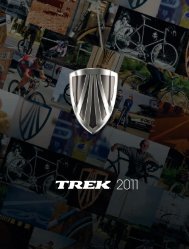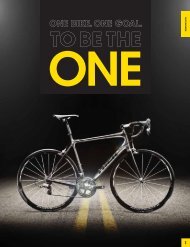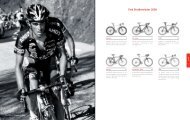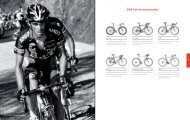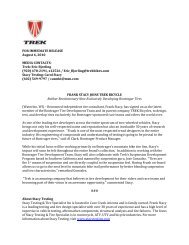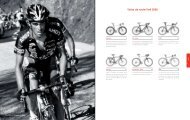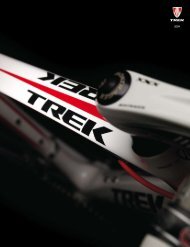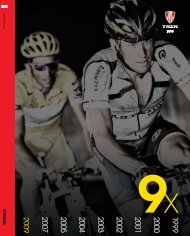TREK CRONUS SERVICE INFORMATION - Trek Bicycle Corporation
TREK CRONUS SERVICE INFORMATION - Trek Bicycle Corporation
TREK CRONUS SERVICE INFORMATION - Trek Bicycle Corporation
You also want an ePaper? Increase the reach of your titles
YUMPU automatically turns print PDFs into web optimized ePapers that Google loves.
FCC Steering System<br />
The Cronus uses the FCC (Fisher Control Column) with a special front hub that is<br />
mated to the front fork. This mating creates a unified structure that is extra strong and<br />
extra stiff, which makes the bicycle corner and handle better. The result is a hub/fork<br />
interface that is 25% stiffer. And with a weight penalty or a few grams at most.<br />
Wider hub flanges<br />
One way to increase handling precision is to use a front wheel that is stiffer laterally.<br />
To make the Cronus front wheel stiffer, we have increased the width of the hub<br />
flanges (Figure 18). This increase in flange width spreads out the spokes, increasing<br />
the bracing angle of the spokes. A wider bracing angle makes the front wheel stiffer<br />
laterally with no increase in weight.<br />
Figure 18. Wide stance of hub flanges, and outboard<br />
placement of fork legs relative to the dropouts<br />
The wider bracing angle requires that the fork legs be slightly wider so that they do not<br />
contact the spokes. The wider stance of the legs also increase lateral stiffness, so that<br />
part is a win-win.<br />
There is a downside, however. In a race, you might need a spare front wheel. This is not<br />
a problem because the Cronus uses a standard 100mm OLD (Over Locknut Dimension)<br />
hub. Any wheel in the follow vehicle will work fine. But your Cronus wheel will not work<br />
in a different bike because the hub flanges or the spokes can contact the blades of a<br />
“standard” fork. The consequences of this type of contact should be obvious.<br />
Figure 19. Large diameter hub end faces mater to<br />
oversized fork tips<br />
Large-diameter end caps on hub<br />
Another way to increase steering precision is to reduce fork leg “twist” that occurs as<br />
the fork is loaded laterally and torsionally, like what occurs when the bike is cornering<br />
on anything less than a perfectly smooth surface.<br />
On most wheels, the biggest source of this twist is the movement between the fork<br />
tips and the hub, even with the quick-release correctly tightened. The easiest way to<br />
reduce this motion is to increase the contact area between the hub end faces and<br />
the fork tips. That is exactly what we did with the Cronus (Figure 19). The larger end<br />
faces create a “block” for the fork tips to rest against. We also gave the fork custom,<br />
over-sized faces to mate with this special hub.<br />
Again, there is a downside. You can still use a wheel from the race vehicle, but your<br />
Cronus wheel can not be used with a different fork. The large faces of the FCC might<br />
completely miss the dropout face on a different fork such that engaging the quick<br />
release can put a bending load on the hub axle and damage the bearings.<br />
Do not put the FCC front wheel in another bike<br />
The hub flanges or the spokes of the Cronus front wheel can contact the blades of<br />
a “standard” fork. The consequences of this type of contact should be obvious<br />
The large faces of the FCC might completely miss the dropout face on a different<br />
fork such that engaging the quick release can put a bending load on the hub axle<br />
and damage the bearings<br />
12 | <strong>TREK</strong> GARY FISHER COLLECTION <strong>SERVICE</strong> <strong>INFORMATION</strong>




